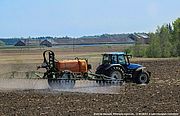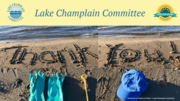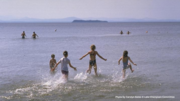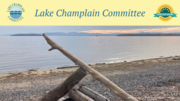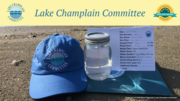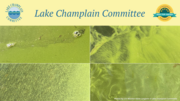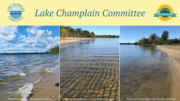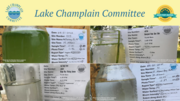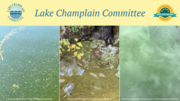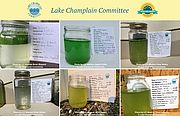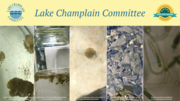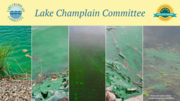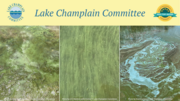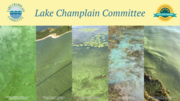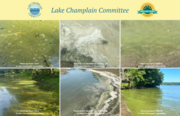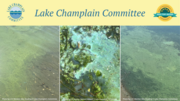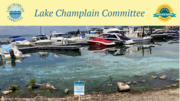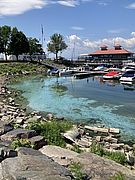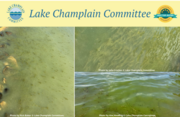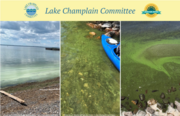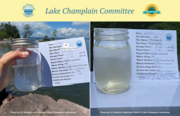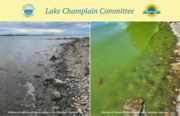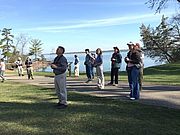In the depths of Lake Champlain, an eel-like creature slithers among the rocks, hunting for a foraged fish dinner. This is no sinister cousin of Champ—this is the burbot (Lota lota), one of Lake Champlain’s only deep-water predator fish (the other one is lake trout). Burbot have a unique look, with small scales forming patterns of blotched green, brown, yellow, and black, all making up their particularly slimy skin. Perhaps their most distinct feature is the single “barbell” protruding from under their chin—think of a long, narrow goatee made of scales rather than hair. They also have large, wide-set, tubular nostrils that protrude from the front of their face, resembling catfish. Read...
News from Selected Month
In the fall of 2022, the Lake Champlain Committee, Vermont Natural Resources Council (VNRC), Shelburne Farms and a host of environmental and conservation organizations collaborated on a tribute to Senator Patrick Leahy in recognition of his unwavering support of communities and the environment during his decades-long tenure in public service. The event was held at Shelburne Farms, overlooking the lake he has done so much to protect and attended by over 500 people. Throughout his career in the US Senate, Patrick Leahy has been an unfailing champion for our region’s—and the nation’s—air, water, and land, and for public health. From the Conte National Wildlife Refuge, across the Green Mountain National Forest, to Lake Champlain, his dedication to safeguarding and investing in natural resources has improved our lives.
“Senator Leahy has led work to protect and restore Lake Champlain for four decades through both authorizing and appropriating legislation” stated LCC Executive Director Lori Fisher. “He has left a legacy that will be remembered and revered for generations to come.” Read...
Sincere thanks to our wonderful team of 2022 cyanobacteria monitors and partner organizations. Monitors faithfully checked Lake Champlain and inland lake locations in wind, rain, sleet, and sun during a 20-week long monitoring season and filed over 2,500 reports on water conditions.
Please join us for the 2023 season if you have some free time every week during the summer and fall and want to give back to a waterbody you love. You’ll receive training in the spring, a cool t-shirt and hat, and support throughout the monitoring season. By volunteering you’ll gather important data to aid research, keep community members apprised of water conditions, and help strengthen and expand the monitoring program. We are looking for monitors for both Lake Champlain and inland lakes. Read...
Check out topical water articles from the Lake Champlain Basin and beyond:
• New VT Pesticide Regs Fall Short of Protecting Human & Ecological Health
• Covid Funds Will Help Improve Water Quality
• Lakes Are Salt Sensitive
• Warming Climate Triggers Harmful Oxygen Loss in Lakes
• Concern Growing Over PFAs in Freshwater Fish
• Cyanobacteria Blooms - an International Problem
Calling all teachers to Camp! LCC and our Champlain Basin Education Initiative (CBEI) partners invite educators to sign up for Watershed for Every Classroom 2023/24. You’ll travel around the Lake Champlain Basin visiting farms, paddling waterways, exploring mountain tops, touring urban areas, and much more! This is a great opportunity to get outdoors and have fun while enriching your curriculum with local, engaging material. Read...
The 2022 cyanobacteria monitoring season has come to a close for LCC monitors and partners. Monitors collectively filed over 2,500 reports during this year’s 20-week season. In the links and photographs below you’ll find our last weekly report compilation for 2022; a link to sign-up to monitor in 2023; clear water scenes from Alburgh Dunes State Park, Stoney Point, and the Burlington shoreline; water samples from Burlington beaches and DAR State Park; stick season images; bike ride beauty; and which monitor filed 143 reports this season. Read...
Think about how you interact with Lake Champlain. Do you live near it? Walk along its shores? Perhaps you swim, boat, paddle, fish, or even just skip the occasional stone. Maybe you photograph the sunsets or watch the birds from the shores. Regardless of what you do, your relationship with Lake Champlain is likely even more fundamental than recreation–the lake sustains those who live within its basin. According to the Lake Champlain Basin Program (LCBP), an estimated 20 million gallons of water are pumped from the Lake each day to supply drinking water to about 145,000 people. Chances are, you are using the lake every time you turn on a tap or flush your toilet. The water that passes through you to keep you alive is the same water that flows through the lake–it is literally your lifeblood. Read...
Site coverage is scant this time of year but all 47 reports from Lake Champlain received during week 19 were of good conditions. For inland lakes, Lake Carmi had a low alert bloom and Joe’s Pond had a high alert. The latter covered a wide swath of shoreline but was short-lived. Blooms can still happen late in the season so please continue to report if you’re still in the area. Read...
Only a scattering of monitoring reports are still coming in as we move into stick season but all that do provide important data on water conditions. Lake Champlain was bloom-free for the second fall week in a row. Lake Champlain was bloom-free again for the fourth week in a row. The lone sighting of cyanobacteria came from Lake Iroquois but we only had reports from four inland lakes. Read...
Good water conditions dominated monitoring reports for the third full week of fall but there are far fewer monitors reporting this time of year on Lake Champlain and inland lakes. This week’s photos don’t show any cyanobacteria but scroll down to see what monitors observed during week 17 including... Read...
Good water conditions dominated monitoring reports for the second week in a row since we moved into the fall season but cyanobacteria blooms continued to show their colors in areas of Lake Champlain and several inland lakes. Read...
Good water conditions dominated monitoring reports during week 15 but blooms showed up in a few Lake Champlain locations as well as several inland lakes. Scroll down to see clear water at Alburgh Dunes State Park, and Graveyard Point on Lake Champlain; blooms at Lake Carmi, Lake Memphremagog, Shelburne Pond, Burlington beaches, and St. Albans Bay; and learn how to differentiate cyanobacteria from duckweed. Read...
Week 14 of monitoring brought cooler weather, fewer sightings of cyanobacteria, but also far fewer monitors to report them. High alert blooms continued in parts of St. Albans Bay, Lake Carmi, and Lake Morey which have all had persistent blooms during the last weeks or months. Read...
While the weather cooled during Week 13 of monitoring, blooms continued in several lakes or bays where they were present previously and showed up in some new locations. On Lake Champlain, high alert conditions were restricted to nutrient-rich St. Albans Bay but there were low alerts in the Inland Sea, Malletts Bay, Main Lake North, and Main Lake South. Blooms also persisted in Lake Carmi, Lake Morey, and Lake Memphremagog. Read...
Throughout his career in the U.S. Senate, Patrick Leahy has been an unfailing champion for our region's– and the nation's – air, water, and land, and the health of our people. From the Conte National Wildlife Refuge, across the Green Mountain National Forest, to Lake Champlain, his dedication to safeguarding and investing in natural resources has improved our lives. Read...
Blooms continued into Week 12 of the monitoring season. You can see visuals of some of them from Lake Memphremagog, Lake Morey, Tinmouth Pond, Shelburne Pond and Lake Champlain’s Arnold Bay and Valcour Island, and Lake Champlain’s Keeler Bay. You’ll also find photos illustrating blue-green blues and the recreational impact of cyanobacteria. Read...
Several monitors reported odd gelatinous globules in the water at several sites in Lake Champlain’s Inland Sea during week 11 of monitoring. Happily they took water samples and photographs and shared the details with us and our partner Dr. Ana Morales-Williams at the University of Vermont’s Rubenstein Ecosystem Science Laboratory. The samples turned out to be Calothrix sp. – a benthic filamentous cyanobacteria. Read...
Happy end of August! As we move towards September, please remember that blooms can still happen as summer wanes which is why we are only about half way through the monitoring season. Blooms have been witnessed through November in our region during past years and the next few months can be very active periods for blooms. Read...
We’ve had a lot of additional subscribers to our weekly cyanobacteria emails so here’s a link to all the weekly reports from the 2022 season in case you’ve missed any of them. They’re worth checking out for the compilation of reporting results, visuals of blooms, and information to help you differentiate cyanobacteria from other lake phenomena. Read...
Happily, Central Main Lake was bloom-free during week 8 of monitoring but blooms persisted in sections of St. Albans Bay and Missisquoi Bay on Lake Champlain and Lake Carmi. After a week of bloom-free reports, cyanobacteria was observed again on Lake Memphremagog. Read...
Bloom reports for the week were restricted to the Central Main Lake, St. Albans Bay, and Missisquoi Bay on Lake Champlain and to Knapp Pond and Lake Carmi for Vermont inland lakes. Read...
Conditions at Lake Champlain and inland Vermont waterways were overall much improved from the previous week. Continued warm weather along with the influx of nutrients from periodic storms could trigger additional cyanobacteria blooms so check the water carefully during your recreational outings and take advantage of the resources and links in this email to learn more about cyanobacteria. Read...
Most of the week was sunny, hot, calm, and humid and blooms took off in many Lake Champlain locations as well as at Lake Carmi. Heat waves are known to promote cyanobacteria blooms in waterways by increasing thermal stratification, allowing cyanobacteria to remain in warm and well-lit surface waters, and encouraging release of phosphorus from lake sediments in shallow lakes. Read...
It's the season when cyanobacteria blooms are most prevalent. Learn how to recognize them by viewing this video produced in partnership with the Lake Champlain Committee (LCC). Read...
Our week 4 cyanobacteria monitoring report for July 10 through July 16 was delayed due to a breakdown with the cyanobacteria tracker. Monitors filed 187 reports during a busy week with blooms showing up in Lake Champlain’s Inland Sea, Main Lake North, Main Lake Central, and Main Lake South and at Lake Carmi and Lake Memphremagog while all other inland waterways reported good conditions. Read...
Another week of mainly good water conditions reported by over 100 monitors from Lake Champlain and inland lake locations. Blooms showed up in Lake Champlain’s Mallett’s Bay, North Lake, and Missisquoi Bay and on Lake Carmi and Lake Memphremagog.
We received mainly good water quality reports during the second week of the cyanobacteria monitoring program. Scroll through this email for details of Week 2 2022 monitoring results from 6/26/22 through 7/2/22; photos of clean water conditions at Lake Champlain’s Button Bay, Oakledge Park, North Beach, and Valcour Island; check out a cool monitor innovation for water sampling without getting wet; and learn about the ingredients for a bloom. Read...
Thank you for signing up to receive the Lake Champlain Committee (LCC) Cyanobacteria monitoring reports! Monitoring began the week of June 19 and will run through early fall. Each week we’ll send you an update about conditions monitors are finding around Lake Champlain and several inland lakes. Read...
It's summer time in the Champlain Valley which means spending time in and around your favorite lakes and ponds. Make sure you know how to asses water conditions! Read...
Happy Earth Day! Here are a few ideas for how to celebrate and protect our planet and the special corner we call home from your friends at the Lake Champlain Committee. Read...




